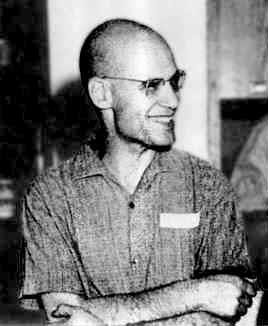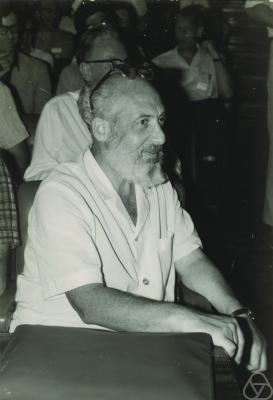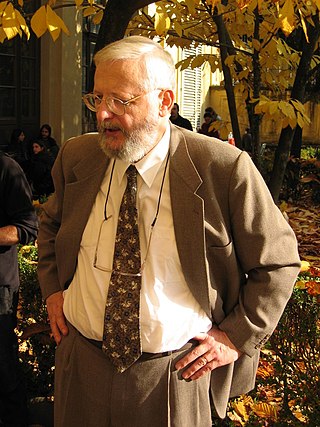Related Research Articles

Alexander Grothendieck,later Alexandre Grothendieck in French was a German-born French mathematician who became the leading figure in the creation of modern algebraic geometry. His research extended the scope of the field and added elements of commutative algebra,homological algebra,sheaf theory,and category theory to its foundations,while his so-called "relative" perspective led to revolutionary advances in many areas of pure mathematics. He is considered by many to be the greatest mathematician of the twentieth century.

Algebraic topology is a branch of mathematics that uses tools from abstract algebra to study topological spaces. The basic goal is to find algebraic invariants that classify topological spaces up to homeomorphism,though usually most classify up to homotopy equivalence.

Vladimir Alexandrovich Voevodsky was a Russian-American mathematician. His work in developing a homotopy theory for algebraic varieties and formulating motivic cohomology led to the award of a Fields Medal in 2002. He is also known for the proof of the Milnor conjecture and motivic Bloch–Kato conjectures and for the univalent foundations of mathematics and homotopy type theory.

Homological algebra is the branch of mathematics that studies homology in a general algebraic setting. It is a relatively young discipline,whose origins can be traced to investigations in combinatorial topology and abstract algebra at the end of the 19th century,chiefly by Henri Poincaréand David Hilbert.
This article gives some very general background to the mathematical idea of topos. This is an aspect of category theory,and has a reputation for being abstruse. The level of abstraction involved cannot be reduced beyond a certain point;but on the other hand context can be given. This is partly in terms of historical development,but also to some extent an explanation of differing attitudes to category theory.

Samuel Eilenberg was a Polish-American mathematician who co-founded category theory and homological algebra.
In mathematics,abstract nonsense,general abstract nonsense,generalized abstract nonsense,and general nonsense are nonderogatory terms used by mathematicians to describe long,theoretical parts of a proof they skip over when readers are expected to be familiar with them. These terms are mainly used for abstract methods related to category theory and homological algebra. More generally,"abstract nonsense" may refer to a proof that relies on category-theoretic methods,or even to the study of category theory itself.

Francis William Lawvere was an American mathematician known for his work in category theory,topos theory and the philosophy of mathematics.
In mathematics,a topos is a category that behaves like the category of sheaves of sets on a topological space. Topoi behave much like the category of sets and possess a notion of localization;they are a direct generalization of point-set topology. The Grothendieck topoi find applications in algebraic geometry;the more general elementary topoi are used in logic.

Colin McLarty is an American logician whose publications have ranged widely in philosophy and the foundations of mathematics,as well as in the history of science and of mathematics.

Ronald Brown FLSW is an English mathematician. Emeritus Professor in the School of Computer Science at Bangor University,he has authored many books and more than 160 journal articles.

Luc Illusie is a French mathematician,specializing in algebraic geometry. His most important work concerns the theory of the cotangent complex and deformations,crystalline cohomology and the De Rham–Witt complex,and logarithmic geometry. In 2012,he was awarded the Émile Picard Medal of the French Academy of Sciences.
Charles Frederick Wells was an American mathematician known for his fundamental contributions to category theory. He was Professor Emeritus of Mathematics at Case Western Reserve University.
The article "Sur quelques points d'algèbre homologique" by Alexander Grothendieck,now often referred to as the Tôhoku paper,was published in 1957 in the Tôhoku Mathematical Journal. It revolutionized the subject of homological algebra,a purely algebraic aspect of algebraic topology. It removed the need to distinguish the cases of modules over a ring and sheaves of abelian groups over a topological space.

Brooke Elizabeth Shipley is an American mathematician. She works as a professor at the University of Illinois at Chicago,where she was head of the Department of Mathematics,Statistics and Computer Science from 2014 to 2022. Her research concerns homotopy theory and homological algebra.
Clark Edward Barwick is an American mathematician and professor of pure mathematics at the University of Edinburgh. His research is centered around homotopy theory,algebraic K-theory,higher category theory,and related areas.
John Stephen Halperin is a Canadian mathematician who deals with differential geometry and algebraic topology.
In mathematics,nonabelian algebraic topology studies an aspect of algebraic topology that involves higher-dimensional algebras.
Mikhail Kapranov,is a Russian mathematician,specializing in algebraic geometry,representation theory,mathematical physics,and category theory. He is currently a professor of the Kavli Institute for the Physics and Mathematics of the Universe at the University of Tokyo.
Jan-Erik Ingvar Roos was a Swedish mathematician whose research interests were in abelian category theory,homological algebra,and related areas.
References
- ↑ "Mathematics and Statistics". McGill University. Retrieved 11 August 2011.
- ↑ Pitts, Andrew (March 1991), "Review of Toposes, Triples and Theories by Barr, M., & Wells, C.", Journal of Symbolic Logic , 56 (1): 340–341, doi:10.2307/2274934, JSTOR 2274934
- ↑ Rota, Gian-Carlo (August 1986), "Toposes, triples and theories: M. Barr and C. Wells, Springer, 1985, 345 pp.", Advances in Mathematics , 61 (2): 184, doi: 10.1016/0001-8708(86)90076-9